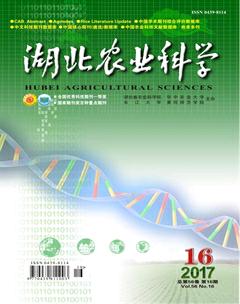快速发展地区经济—资源—环境系统协调发展研究
程潇雨+渠丽萍
摘要:鄂州市作为湖北省第一个城乡一体化试点城市,正在积极、快速推进城镇化发展,全力打造新型城镇化城市。通过建立城市经济-资源-环境(ERE)系统评价指标体系,利用主成分分析法、回归分析法、隶属度函数构建ERE系统协调发展评价模型,测算了鄂州市2000-2013年ERE系统的综合发展水平及协调发展度。结果表明,①鄂州市经济发展迅速,资源、环境发展相对滞后。②经济-资源-环境系统协调发展度2000-2013年平均处于中级协调水平且有下降的趋势,经济-资源子系统矛盾是阻碍ERE系统协调发展度上升的主要原因。③资源消耗、环境保护问题成为制约鄂州城市发展的关键,应根据鄂州市实际情况制定协调发展政策和措施。
关键词:城镇化;经济-资源-环境系统;协调发展;工业化;鄂州市
中图分类号:X24 文献标识码:A 文章编号:0439-8114(2017)16-3155-05
DOI:10.14088/j.cnki.issn0439-8114.2017.16.040
Research on Coordinative Development of Economy Research Environment System in Rapidly Development Regions:A Case Study of Ezhou in Hubei
CHENG Xiao-yu,QU Li-ping
(School of Public Administration, China University of Geosciences,Wuhan 430074,China)
Abstract: As the first pilot city of urban-rural integration in Hubei, Ezhou forward the development of urbanization in a positive rapid manner, and to build new-type urbanization city with all its strength. Establishing an evaluation index system for the coordinate developmental degree of ERE system, which reflects the goal of ecological civilization constructing. By means of the PCA method,regression analysis method and membership function,a coordinating development evaluating model of ERE system was established. The comprehensive developmental level of ERE system in Ezhou was calculated from 2000 to 2013. The results showed that firstlyeconomic development was rapid in Ezhou, while environment and resources development were lagging behind. Secondly, the comprehensive developmental level of ERE system was in the intermediate coordination average level during 2000 to 2013, showed a trend of decline in recent years. The main reason is economy and resource system coordinative developmental degree declines. Thirdly, the problem of resources consumption and environment protection became the key to restricting the development of Ezhou, therefore the coordinated development measures and policies should be built according to the real situation of Ezhou.
Key words: urbanization; ERE system; coordinative development; industrialization; Ezhou
城鎮化是经济发展、生产力提高、社会进步的必然趋势。改革开放以来,伴随着工业化进程加速,中国城镇化经历了一个起点低、速度快的发展过程,城镇化率从1978年的17.9%提升到2013年的53.7%,年均提高1.02个百分点。城镇化作为工业化和现代化的载体与平台,对促进经济发展和推进现代化建设发挥了有力的支撑作用[1]。但是城镇化进程的加快促使人类过度追求经济的发展,毫无节制的滥用资源,同时对环境也造成较大的破坏。这也导致了经济-资源-环境(ERE)系统发展的不协调日益明显。加快经济转型和深入发展健康城市化则是解决目前中国经济发展所面临一系列资源环境问题的必然选择。因此,对经济-资源-环境系统发展的协调性做定量评价,是实现社会经济效益与资源环境效益双赢的首要前提。
国外学者对于经济、资源、环境系统耦合的研究起源于19世纪末,形成了大量理论与实证研究成果。美国学者Grossman等[2]提出了环境库兹涅茨曲线,表明环境污染与经济增长呈倒“U”型。Vehmas等[3]较早的对资源环境压力与经济增长的脱钩关系进行了研究。Siebert[4]认为经济活动规模超过环境所承载限度将会严重影响生态系统。国内学者对此也有系统深入的分析,研究内容主要集中在经济-资源-环境系统耦合的理论、协调耦合度分析、系统动态模拟等方面。马世骏等[5]构建了社会-经济-自然复合生态系统观,揭示了三者之间的相互作用机制。随后,齐晓娟等[6]、刘承良等[7]、胡彪等[8]、于忠华等[9]、贺晟晨等[10]、秦伟山等[11]从多学科、多尺度研究了经济、资源、环境系统的协调耦合问题。但研究尺度以省区、城市群(经济区)为主,研究区域主要分布在发达地区和西部生态脆弱区,对于中部地区中小城市实证研究相对薄弱。近十三年鄂州城镇化水平年均提高1.5%左右,经济增速基本保持在12%以上。从速度上衡量,鄂州市属于中部快速城镇化地区中较为典型的城市;从区位上看,鄂州市作为湖北省第一批改革开放试验区,毗邻武汉,是“1+8”武汉城市圈成员之一。endprint

